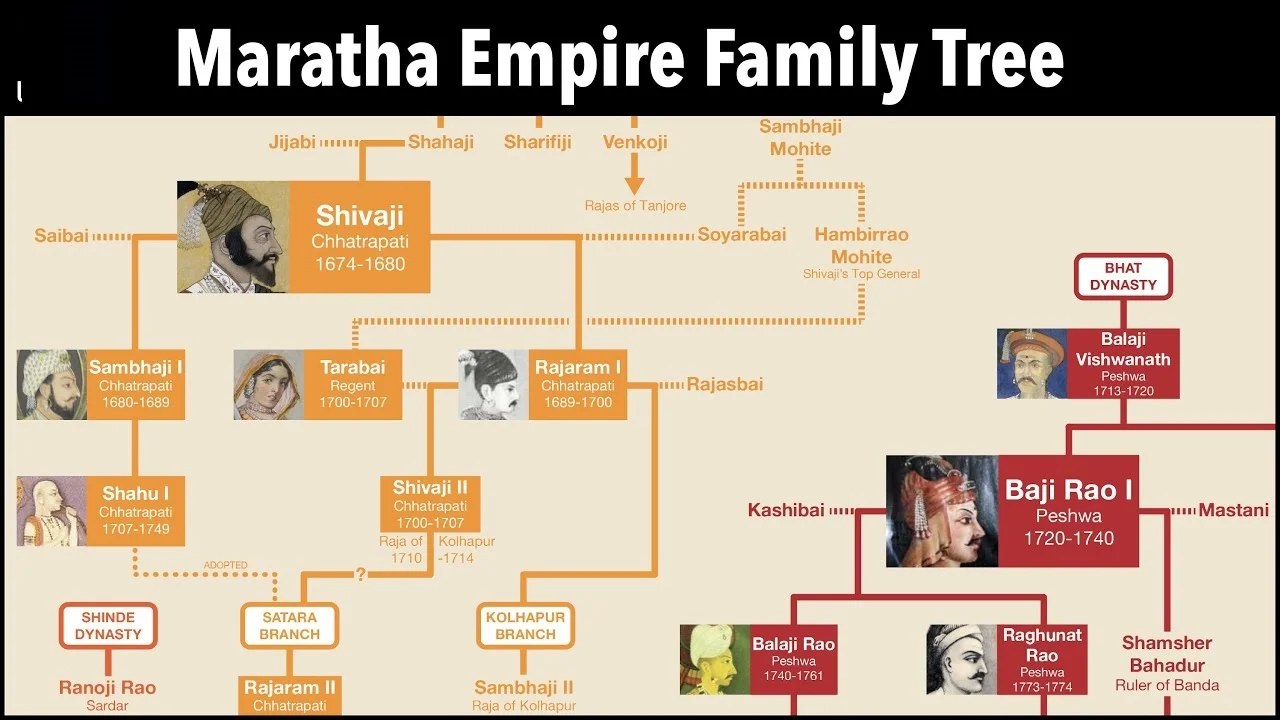
History of Maratha Empire and Family Tree
History of Maratha Empire and Family Tree
Shivaji (1627 – 1680)
- Known as the “father of the Maratha Nation” .
- He inherited the jagir of Poona from his father Shahji Bonsle in 1637.
- His mother Jijabai is often regarded as the master or the guru of Shivaji Maharaj.
- In 1659, he defeated Adilshahi general Afzal Khan in the Battle of Pratapgad.
- In 1665 AD, Aurangzeb’s general Mirza Raja Jai Singh I defeated the Marathas & had a Purandar treaty.
- As per the treaty of Purandar he surrendered 23 forts & Also agreed to help Mughals to fight against the Bijapur Sultans.
- In 1666, Shivaji was invited to the court of Mughal Emperor Aurangzeb and he was arrested. But Shivaji escaped very smartly.
- In 1674 AD, he adopted the title of “Chatrapati” & founded the powerful Maratha Empire.
Shivaji’s Administration
- King was the center of the government & was assisted by 8 ministers →“Ashtapradhans” .
- Peshwa → Finance & general administration. Later he became the prime minister.
- Sar-i-Naubat or Senapati → Military commander.
- Amatya → Accountant General.
- Waqenavis → Intelligence, posts & household affairs.
- Sachiv → Correspondence.
- Sumanta → aster of ceremonies.
- Nyayadish → Justice.
- Panditarao → Charities and religious administration.
- Administrative reforms of Shivaji were based on the practices of the Deccan sultanates. Ex:- Peshwa → Persian title.
Revenue system of Maratha empire
- Based on that of Malik Amber of Ahmadnagar & appointed his own revenue officials called karkuns.
- Lands were measured by using the measuring rod called “kathi”.
- Lands were also classified into 3 categories → paddy fields, garden lands and hilly tracks.
Taxes
- Chauth & sardeshmukhi were the taxes collected only in the neighbouring territories of the Mughal empire.
- Chauth → one fourth of the land revenue (avoid the Maratha raids).
- Sardeshmukhi → 10%t on lands which the Marathas claimed hereditary rights.
Military system
- Regular army consisted of about 30000 to 40000 cavalry supervised byhavaildars & they were given fixed salaries.
2 divisions in the Maratha cavalry →
1. bargirs, equipped and paid by the state &
2. silahdars, maintained by the nobles.
- By the end of his reign, Shivaji had about 240 forts. Each fort was put under the charge of three officers of equal rank.
Peshwas (1713 – 1818)
Balaji Viswanath (1713-1720)
- Began his career as a small revenue official & was given the title of Sena Karte by Shahu 1708.
- He became Peshwa in 1730 & made the post as hereditary.
- Played a crucial role in the final victory of Shahu over the Mughuls by winning over almost all the Marathas Sardas to the side of Shahu.
- Also cncluded an agreement with the Sayyid brothers (1719) by which the Mogul emperor recognized Shahu as the king of the Swarajya.
Baji Rao I (1720 -1740)
- Eldest son of Balaji Viswanath, became Pashwa at the yound age of 20.
- Considered the greatest exponent of gurrilla tactic after Shivaji & Maratha Power reached zenith under him.
- Conquered Bassein & Salsette from the Portuguese (1733).
- Defeated the Nizar-ul-Mulk near Bhopal & concluded the Treaty of Durai Sarai by which he got Malwa & Bundelkhand from the latter (1737).
Balaji Baji Rao (1740 -61)
- Known as Nana Saheb, he succeeded his father at the age of 20.
- After the death of Sahu (1749), the management of all state of affairs was left in his hands.
- In an agreement the Peshwa (1752) was to protect the Mughal empire from internal and external enemies in return for the Chauth.
Third Battle of Panipat – 1761
- Between the Afghan commander Ahmad Shah Durrani & the Maratha general Sadashiv Rao.
- Finally Marathas were routed by the forces of Ahmad Shah Abdali .
Shivaji Maharaj family tree
List of queens of Shivaji Maharaj-
- Saibai (Nimbalkar)
- Soyarabai (Mohite)
- Putalabai (Palkar)
- Gunwantabai (Ingle)
- Sagunabai (Shirke)
- Kashibai (Jadhav)
- Lakshmibai (Vichare)
- Sakwarbai (Gaikwad)
Shivaji Maharaj: Children
Saibai
- Sambhaji (Son)
- Sakhubai (Daughter)
- Ranubai (Daughter)
- Ambikabai (Daughter)
Soyarabai
- Rajaram (Son)
- Deepabai (Daughter)
Sagunabai
- Rajkunvarbai (Daughter)
Sakwarbai
- Kamlabai (Daughter)
Related Articales
Recently Posted
-
भगवान गौतम बुद्ध जीवन परिचय | Gautam Buddha in Hindi
December 15, 2022. -
कार्बन के अपररूप Allotropes of Carbon in Hindi
November 5, 2022. -
मिश्र धातु किसे कहते हैं? उपयोग, नाम, गुण Alloy in Hindi
July 27, 2022. -
गलनांक किसे कहते हैं? परिभाषा, उदाहरण Melting Point in Hindi
July 20, 2022. -
परिमाप किसे कहते हैं? Perimeter in Hindi
July 19, 2022.




